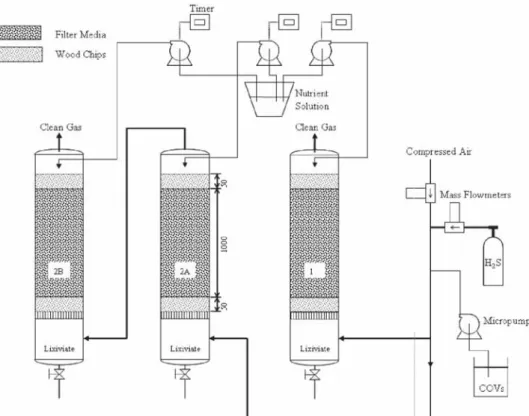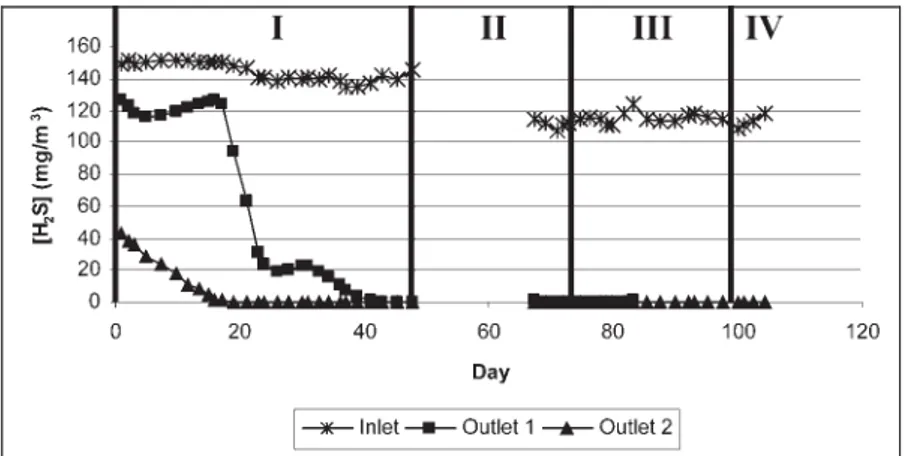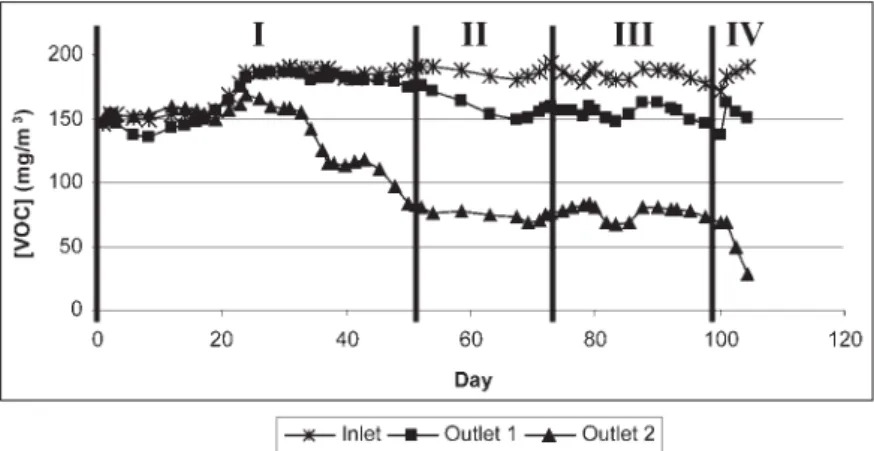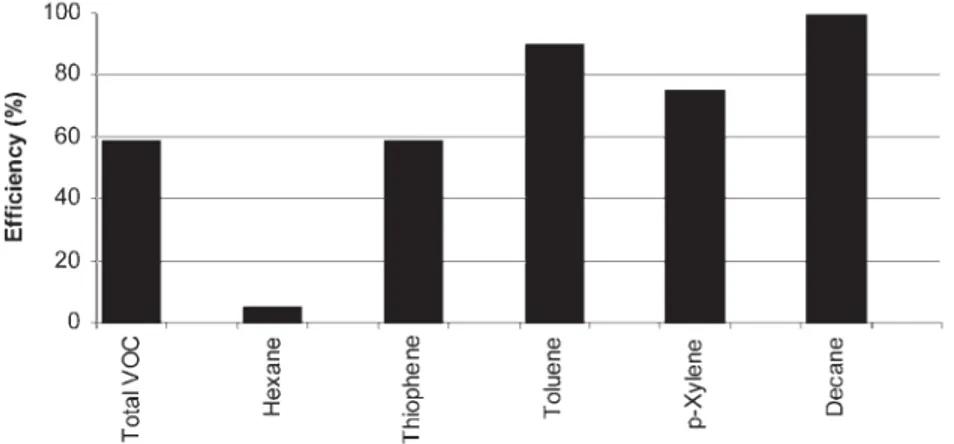TítuloBiofiltration of bitumen vapours Operational aspects
Texto completo
(2) 588. M. GIRARD, J. L. FANLO, N. TURGEON, G. BUELNA AND P. LESSARD. VOCs are organic compounds which have a vapour pressure above 10 Pa at 20°C according to European regulations (Fanlo, 2006). Due to the vague aspect of this definition, these components have a wide range of effects on human health and the environment. VOCs can cause nausea, headaches, irritation of the nervous and respiratory systems and even certain cancers (Delhoménie and Heitz, 2005). They also contribute to the production of tropospheric ozone which is an important component of smog (Thérrien, 2005). Odours can be defined as the result of interpretation by the brain of an interaction between a volatile compound and the olfactory senses (Fanlo, 2006). The measurement of odours is therefore difficult since there is no way to know beforehand whether a specific compound is odorous or not. Odours can be described by their quality, hedonic tone and intensity and are often composed of sulphur, nitrogen or organic compounds (Brandy, 1997). Reduced sulphur compounds, such as hydrogen sulphide (H2S), are reported to by highly odorous molecules. Symptoms can vary from simple discomfort, allergies or nausea to loss of concentration and depression (Météoglobe Canada Inc., 1993). Traditionally, the emission of air pollutants has been managed by physicochemical treatment methods. However, biological treatment technologies are rapidly gaining in popularity because of their low investment and operating costs as well as the simplicity of their operation (Michel, 1997). There are three types of bioreactors, the biofilter, the bioscrubber and the biotrickling filter, which are distinguished by the mobility of the biomass and the liquid phase (Devinny et al., 1999). Biofiltration is the oldest and most widespread biotechnology for the treatment of air pollutants (Jorio and Heitz, 1999). There are two distinct steps in the biofiltration process: transfer of the pollutants to the aqueous phase or the filter media and their degradation by the microorganisms (Malhautier et al., 2005). There are many parameters to consider when designing and operating a biofilter, such as filter media, air flow, pollutants, moisture content, pressure loss, microorganisms, temperature and pH. Biofiltration has been used to treat a great deal of different components, several authors have compiled some of the industrial and laboratory applications of this technology (Easter et al., 2005; Iranpour et al., 2005; Mulligan, 2002; Kennes and Thalasso, 1998). In recent years, the industrial sector of storage and use of bitumen has been in the spotlight concerning its gaseous emissions. Bitumen is a residue of the distillation of petroleum which is used in many industries, as in asphalt production for example. When the bitumen is stored, it must be kept hot, around 170°C, to maintain its fluidity. This causes an important production of bitumen vapours, which can then disturb a great deal of people. If solid bitumen contains mainly heavy hydrocarbons, its vapour is composed of much lighter compounds, such as VOCs and odourous substances of which H2S is the most important (Cook et al., 1999). Biofiltration of single substances or of compounds from the same chemical family (sulphur compounds, VOCs, etc.) is well documented but few studies have.
(3) BIOFILTRATION OF BITUMEN VAPOURS-OPERATIONAL ASPECTS. 589. examined the simultaneous treatment of pollutants from different families as is the case of bitumen vapours. Koe and Liang (2005) studied two biofilter configurations for the co-treatment of toluene and H2S. They found that H2S significantly decreased the pH of the filter bed without pH control and that a two-stage biofilter was more efficient to treat H2S and toluene. Closer to bitumen vapours, Cook et al. (1999) published a paper on the biofiltration of emissions from a polymer-modified asphalt plant. The objective of their study was the removal of H2S since it was considered as the main contributor to the odour problem. This was achieved very well except during peaks of H2S which reached 30 000 ppmv. However, VOC removal was negligible. The general objective of this study was to determine the potential of biofiltration for the treatment of air containing bitumen vapours. Two biofilters configurations were studied: a single-stage system and a two-stage system. A secondary objective was to determine the operating parameters necessary for proper operation.. 2 MATERIALS AND METHODS 2.1 BITUMEN VAPOUR ANALYSIS Considering the technical difficulties of reproducing bitumen vapours in a laboratory setting, it was decided to create a synthetic gas representative of these vapours to test the pilot-scale biofilters. A portion of solid bitumen was first heated to 170°C and then samples of vapour were drawn directly from the headspace above the bitumen. Analysis of the vapours was done first with a GC-MS (gas chromatograph with a mass spectrometer detector) for a general approach and then with a GC-PFPD (gas chromatograph with a pulsed flame photometric detector) for sulphur compounds. It was possible to identify over a hundred compounds, ranging from light to heavy hydrocarbons (C-2 to C-24) with several sulphur compounds. Subsequently, this analysis was used to select specific compounds to incorporate in the synthetic gas. The final composition of the gas is given in table 1. Table 1. Composition of the synthetic gas. Component Hexane Decane Toluene p-Xylene Thiophene H2 S. Concentration(mg·m3) 73.5 73.5 12.5 12.5 3 150.
(4) 590. M. GIRARD, J. L. FANLO, N. TURGEON, G. BUELNA AND P. LESSARD. 2.2 EXPERIMENTAL SETUP The experimental setup used for this study is represented by the schematic in Figure 1.. Figure 1. Schematic of the biofilters.. The biofilters are 25 cm in diameter and were packed with 1 m of an organic filter media made up of wood chips and peat moss. Biofilter 1 was composed only of column 1 and biofilter 2 was composed of columns 2A and 2B. The gas flow rate was constant at 4.9 m3·h-1, corresponding to a gas velocity of 100 m·h-1 and empty bed residence times of 36 and 72 seconds for biofilter 1 and 2 respectively. H2S was introduced with a bottle of liquefied gas while the blend of the five VOCs was injected using a micropump. A nutrient solution was periodically sprayed on the surface of the biofilters to maintain proper humidity and to ensure bacterial growth. Sampling ports were located at the inlet, the outlet and at 5 equidistant intervals over the height of each biofilter. The two biofilters were operated for a period of 106 days according to the schedule in table 2:.
(5) BIOFILTRATION OF BITUMEN VAPOURS-OPERATIONAL ASPECTS. 591. Table 2. Operation schedule. Phase I II III IV. Description Start-up H2S starvation period pH control Removal of hexane. Duration (d) 50 23 29 4. 2.3 ANALYTICAL METHODS H2S concentrations were measured with a gas chromatograph (GC) equipped with a photo-ionisation detector (PID) from HNU Systems with an oven temperature of 80°C, a temperature of 200°C for the injector and the detector and an analysis time of 2 minutes. Total VOC concentrations were determined with a Graphite 700 flame ionisation detector (FID) from Cozma which was calibrated with methane at 100 mg·m-3 before every series of measurements. Individual VOC concentrations were evaluated with an HP-5890 Series II GC-FID equipped with a 30m×0.53mm HP-1 column. Oven temperature was held at 80°C and analysis time was 6 minutes. Samples were injected automatically with the sampling pump on each of three systems.. 3 RESULTS AND DISCUSSION 3.1 H2S ELIMINATION A graph of the H2S concentration versus time is presented in Figure 2.. Figure 2. H2S concentration versus time..
(6) 592. M. GIRARD, J. L. FANLO, N. TURGEON, G. BUELNA AND P. LESSARD. Immediately after start-up, the biofilters offered a certain treatment, system 1 reduced the H2S concentration to about 130 mg·m-3 while system 2 reached 45 mg·m-3. Two weeks later, H2S was removed below the detection limit by biofilter 2. The rapid drop for biofilter 1 around day 20 was due to an increase in liquid flow to rectify the inadequate moisture level in this biofilter. After 40 days of operation, both biofilters removed all of the H2S that was introduced. Even the starvation period (phase II) between days 50 and 64 had no effect on performance. During the first 70 days of operation, lixiviate pH slowly decreased and reached values around 1 due to sulphuric acid production from the biodegradation of H2S. To counteract this acidification and maintain a neutral pH, sodium bicarbonate was added in the nutrient solution during phase III. This adjustment of the pH had no obvious effect on H2S removal. Using the intermediate sampling ports, it was possible to determine that only 80 cm of biofilter 1 and 60 cm of biofilter were necessary to remove all the H2S. This corresponds to elimination capacities of 18.8 g·m-3·h-1 and 25 g·m-3·h-1. 3.2 VOC TREATMENT Results for total VOC concentration in this section are given in methane equivalents since the FID was calibrated using this gas. A graph of total VOC concentrations versus time is given in Figure 3.. Figure 3. Total VOC concentration versus time.. From Figure 3, it can be seen that there is no biodegradation for the first 25 days, then biofilter 2 starts removing the VOCs and their concentration falls to a stable value of 75 mg·m-3 on day 50. It is this stabilization that was used to define the start-up time of the biofilters. During this first phase, biofilter 1 only begins to treat.
(7) BIOFILTRATION OF BITUMEN VAPOURS-OPERATIONAL ASPECTS. 593. VOCs, removing about 10 mg·m-3. There is an interesting connection to be made between the complete removal of H2S and the start of VOC treatment by biofilter 2. This could just be a coincidence, but it could also be caused by the acidifying effect of H2S (Koe and Liang, 2005). However, it could also be the standard time required by the microorganisms to adapt to the specific VOCs in the synthetic gas. During phase II, H2S starvation had a negligible effect on biofilter 2, but a significant improvement of VOC removal for biofilter 1 was observed. Adjustment of the pH in phase III didn’t seem to have any effect on VOC elimination. Maximum removal efficiencies of 20% and 60% were obtained with biofilter 1 and 2 respectively, corresponding to elimination capacities of 3.5 g·m-3·h-1 and 5.25 g·m-3·h-1. 3.3 HEXANE REMOVAL To explain the mediocre results concerning total VOC removal, individual VOC concentrations were examined. Figure 4 shows the average removal efficiency for days 53 to 67 for the five individual VOCs and the total VOC.. Figure 4. Individual VOC Removal Efficiencies for Days 53 to 67.. From the data shown in Figure 4, it is possible to establish an order of biodegradability: alkanes > aromatics > thiophene. However, hexane does not fit in this classification since it was barely treated by the biofilters. It was also this compound that greatly limited overall VOC elimination. According to Maier et al. (2000), medium size alkanes (n-alkanes ranging from C-10 to C-18) are more biodegradable than smaller and larger molecules of the same family. The low solubility of long alkanes reduces their bioavailability while it is a toxicity problem with short alkanes. This could explain why hexane was not removed by the biofilters whereas decane was almost entirely treated..
(8) 594. M. GIRARD, J. L. FANLO, N. TURGEON, G. BUELNA AND P. LESSARD. Knowing this, it is possible to recalculate removal efficiencies while considering only the four VOCs other than hexane. Maximum values of 41% and 98% were obtained for biofilters 1 and 2 using this method. It was also decided to remove hexane from the synthetic gas while maintaining the same total VOC load in phase IV. This change caused a rapid decrease in total VOC concentrations for both biofilters as can be seen in Figure 3. Unfortunately, due to technical difficulties, it was not possible to pursue the experiments further to observe complete VOC removal. Nevertheless, it was possible to obtain elimination capacities of 6.5 g·m-3·h-1 and 8.6 g·m-3·h-1 for biofilters 1 and 2.. 4 CONCLUSIONS This study was carried out in response to odour problems around a bitumen mixing and storage plant. The potential of biofiltration for the treatment of a synthetic gas representative of bitumen vapours was shown. Of the two configurations tested, the two-stage system proved to be more efficient for the simultaneous removal of H2S and VOCs. Adequate filter bed moisture content and pH were essential operating parameters for proper performance. Maximum elimination capacities of 25 g·m-3·h-1 for H2S and 8.6 g·m-3·h-1 for VOCs were obtained with the two-stage biofilter.. 5 ACKNOWLEDGEMENTS This project was funded by the Laboratoire du Génie de l’Environnement Industriel (LGEI) at the École des Mines d’Alès (EMA) in France and by the Industrial Research Center of Québec (CRIQ). Matthieu Girard was supported financially by a Master’s grant from the Natural Sciences and Engineering Research Council of Canada (NSERC).. REFERENCES Brandy, J. (1997) Hydrodynamique et transfert gaz-liquide dans un bioréacteur. Application au transfert d’émissions gazeuses par lavage biologique. Thesis from the Université de Pau et des pays de l’Adour, France. Cook, L.L., Gostomski, P.A. and Appel, W.A. (1999) Biofiltration of asphalt emissions: Full-scale operation treating off-gases from polymer-modified asphalt production. Environ. Prog. 18(3): 178-187..
(9) BIOFILTRATION OF BITUMEN VAPOURS-OPERATIONAL ASPECTS. 595. Delhoménie, M-C. and Heitz, M. (2005) Biofiltration of air: a review. Critical Reviews Biotechnol. 25(1-2): 53-72. Devinny, J.S., Deshusses, M.A. and Webster, T.S. (1999) Biofiltration for air pollution control. CRC Press LLC, United States. 109 p. Easter, C., Quigley, C., Burrowesa P., Witherspoon, J. and Apgar, D. (2005) Odor and air emissions control using biotechnology for both collection and wastewater treatment systems. Chem. Engin. J. 113: 93-104 Fanlo, J.-L. (2006) Odeurs et Composés Organiques Volatiles-Contexte général, Problématique et Procédés de traitement, Course Notes, École des Mines d’Alès, France Iranpour R., Cox H.H.J., Deshusses, M.A. and Schroeder, E.D. (2005) Literature review of air pollution control biofilters and biotrickling filters for odor and volatile organic compound removal. Environ. Prog. 24(3): 254-267. Jorio, H. and Heitz, M. (1999) Traitement de l’air par biofiltration, Canadian Journal of Civil Engin. 26: 402-424. Kennes, C. and Thalasso, F. (1998) Waste gas biotreatment technology. J. Chem. Technol. Biotechnol. 72(4): 303-319. Koe, L.C.C. and Liang, J. (2005) Comparison of two-stage and single-stage biofiltration for H2S and toluene co-treatment. Proceedings of the International Congress Biotechniques for Air Pollution Control, La Coruña, Spain, October 5-7 2005, pp. 95-102. Maier, R.M., Pepper I.L. and Gerba, C.P. (2000) Environmental Microbiology, Academic Press, United States, pages 380, 381 and 385. Malhautier, L., Khammer, N., Bayle, S. and Fanlo, J-L. (2005) Biofiltration of volatile organic compounds. Appl. Microbiol. Biotechnol. 68(1): 16-22. Météoglobe Canada Inc. (1993) Applicabilité de méthodes de mesure d’odeurs au voisinage des lieux de production, d’entreposage et l’épandage du purin de porc : rapport final, Québec: Ministère de l’Environnement, 193 pages, QEN/AE93-8/6 Michel, M-C. (1997) Traitement de l’hydrogène sulfuré par biolavage, Master’s Dissertation. Laval University, Québec. Mulligan, C.N. (2002) Environmental Biotechnology – Technologies for Air, Water, Soil, and Wastes, ABS Consulting, United States, pages 39-76. Thérrien, M. (2005) Les composés organiques volatils (COV) dans l’air ambiant au Québec, Bilan 1989-1999, Québec, Ministère du Développement durable, de l’Environnement et des Parcs, Direction du suivi de l’état de l’environnement, ISBN 2-550-46063-4, Envirodoq n° ENV/ 2005/0283, 24 pages..
(10)
Figure




Documento similar
From the phenomenology associated with contexts (C.1), for the statement of task T 1.1 , the future teachers use their knowledge of situations of the personal
This study employs a test protocol based on a 3-point bending DMA (Dynamic Mechanical An- alyzer) configuration to assess the influence of the type of filler and the bitumen
No obstante, como esta enfermedad afecta a cada persona de manera diferente, no todas las opciones de cuidado y tratamiento pueden ser apropiadas para cada individuo.. La forma
– Spherical Mexican hat wavelet on the sphere software (developed by the Observational Cosmology and Instrumentation Group at
This paper reviews the current available bone targeting drug delivery systems, focusing on nanoparticles, proposed for osteoporosis treatment.. Bone targeting delivery systems is
In the preparation of this report, the Venice Commission has relied on the comments of its rapporteurs; its recently adopted Report on Respect for Democracy, Human Rights and the Rule
Díaz Soto has raised the point about banning religious garb in the ―public space.‖ He states, ―for example, in most Spanish public Universities, there is a Catholic chapel
We seek to characterize the transport in a time-dependent flow by identifying coherent structures in phase space, in particular, hyperbolic points and the associated unstable and